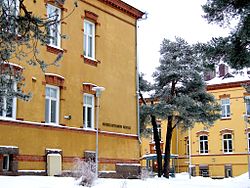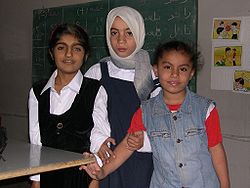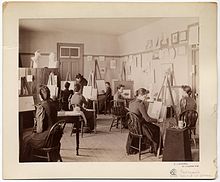- Deaf culture
-
Deaf culture describes the social beliefs, behaviors, art, literary traditions, history, values and shared institutions of communities that are affected by deafness and which use sign languages as the main means of communication. When used as a cultural label, the word deaf is often written with a capital D, and referred to as "big D Deaf" in speech and sign. When used as a label for the audiological condition, it is written with a lower case d.
Members of the Deaf community tend to view deafness as a difference in human experience rather than a disability.[1][2]
The community may include family members of deaf people and sign-language interpreters who identify with Deaf culture and does not automatically include all people who are deaf or hard of hearing.[3] According to Anna Mindess, "it is not the extent of hearing loss that defines a member of the Deaf community but the individual's own sense of identity and resultant actions."[4] As with all social groups that a person chooses to belong to, a person is a member of the Deaf community if he or she "identifies him/herself as a member of the Deaf community, and other members accept that person as a part of the community."[5]
Deaf culture is recognised under article 30, paragraph 4 of the United Nations Convention on the Rights of Persons with Disabilities, which states that "Persons with disabilities shall be entitled, on an equal basis with others, to recognition and support of their specific cultural and linguistic identity, including sign languages and deaf culture."
Contents
Acquisition of Deaf culture
Historically, Deaf culture has often been acquired within schools for the deaf and within Deaf social clubs, both of which unite deaf people into communities with which they can identify.[1] Becoming Deaf culturally can occur at different times for different people, depending on the circumstances of one's life. A small proportion of deaf individuals acquire sign language and Deaf culture in infancy from Deaf parents, others acquire it through attendance at schools, and yet others may not be exposed to sign language and Deaf culture until college or a time after that.[4]
Although up to fifty percent of deafness has genetic causes, less than five percent of deaf people have a Deaf parent,[6] so Deaf communities are unusual among cultural groups in that most members do not acquire their cultural identities from parents.[7]
Diversity within Deaf culture
Anna Mindess notes that there is "not just one homogenous Deaf culture."[4] There are many distinct Deaf communities around the world, which communicate using different sign languages and exhibit different cultural norms. Deaf identity also intersects with other kinds of cultural identity. Deaf culture intersects with nationality, education, race, ethnicity, gender, class, sexual orientation, and other identity markers, leading to a culture that is at once quite small and also tremendously diverse. The extent to which people identify primarily with their Deaf identity rather than their membership in other intersecting cultural groups also varies. Mindess notes a 1989 study, which "found that 87 percent of black Deaf people polled identified with their Black culture first."[4]
Characteristics of Deaf culture
Sign languages
Members of Deaf cultures communicate via sign languages. There are over 200 distinct, naturally-occurring sign languages in the world. Although the United Kingdom and the United States share English as the most common spoken language, the sign languages used in these countries differ markedly. Due to the origins of deaf education in the United States, American Sign Language is most closely related to French Sign Language.
Apart from using sign languages, Deaf culture has typical beliefs, values, and arts that help to define it.
Values and beliefs
- A positive attitude toward being deaf is typical in Deaf cultural groups. Deafness is not generally considered a condition that needs to be fixed.[4]
- The use of a sign language is central to Deaf cultural identity. Oralist approaches to educating deaf children thereby pose a threat to the continued existence of Deaf culture. Members of Deaf communities may also oppose technological innovations like cochlear implants and hearing aids for the same reason.
- Culturally Deaf people value the use of natural sign languages that exhibit their own grammatical conventions, such as American Sign Language and British Sign Language, over signed versions of English or other spoken languages. Note that spoken English, written English and signed English are three different symbolic systems for expressing the same language.[8]
- Deaf communities strongly oppose discrimination against deaf people.
- Deaf culture in the United States tends to be collectivist rather than individualist; culturally Deaf people value the group.[4]
Behavioral norms
- Culturally Deaf people have rules of etiquette for getting attention, walking through signed conversations, leave-taking, and otherwise politely negotiating a signing environment.
- Deaf people also keep each other informed of what is going on in one's environment. It is common to provide detailed information when leaving early or arriving late; withholding such information may be considered rude.[4]
- Deaf people may be more direct or blunt than their hearing counterparts.[4]
- When giving introductions, Deaf people typically try to find common ground; since the Deaf community is relatively small, Deaf people usually know some other Deaf people in common. "The search for connections is the search for connectedness."[4]
- Deaf people may also consider time differently. Showing up early to large scale events, such as lectures, is typical. This may be motivated by the need to get a seat that provides the best visual clarity for the deaf person. Deaf people may also be late to social events. However, at Deaf social events such as parties, it is common for Deaf people to stay for elongated amounts of time, for the solidarity and conversations at social gatherings are valued by Deaf people.
Literary traditions and arts
Main article: American Sign Language literatureA strong tradition of poetry and storytelling exists in American Sign Language and other signed languages. Some prominent performers in the U.S. include Clayton Valli, Benjamin Bahan, Ella Mae Lentz, Manny Hernandez, C.J. Jones, Debbie Rennie, Patrick Graybill, Peter Cook, and many others. Their works are now increasingly available on video.[9]
Culturally Deaf people have also represented themselves in the dominant written languages of their nations.[10]
Deaf artists such as Betty G. Miller and Chuck Baird have produced visual artwork that conveys a Deaf worldview.[7]
History
Deaf people who sign are intensely proud of their history. In the United States, they recount the story of Laurent Clerc, a Deaf educator, coming to the United States from France in 1816 to help found the first permanent school for deaf children in the country.[10]
Another well-known event is the 1880 Second International Congress on Education of the Deaf in Milan, Italy, where hearing educators voted to embrace oral education and remove sign language from the classroom.[11] This effort resulted in strong opposition within Deaf cultures today to the oralist method of teaching deaf children to speak and lip read with limited or no use of sign language in the classroom. The method is intended to make it easier for deaf children to integrate into hearing communities, but the benefits of learning in such an environment are disputed. The use of sign language is central to Deaf identity and attempts to limit its use are viewed as an attack.
Deaf culture revolves around such institutions as residential schools for deaf students, universities for deaf students (including Gallaudet University, South West Collegiate Institute for the Deaf, and the National Technical Institute for the Deaf), Deaf clubs, Deaf athletic leagues, Deaf social organizations (such as the Deaf Professional Happy Hour), Deaf religious groups, and an array of conferences and festivals, such as the Deaf Way II Conference and Festival and the World Federation of the Deaf conferences.
Deaf clubs, popular in the 1940s and 1950s, were also an important part of Deaf culture. During this time there were very few places that the Deaf could call their own; places run by Deaf people for Deaf people. Deaf clubs were the solution to this need. Money was made by selling alcohol and hosting card games. Sometimes these ventures were so successful that the building used by the club was able to be purchased. However, the main attraction of these clubs was that they provided a place that Deaf people could go to be around other Deaf people, sometimes sharing stories, hosting parties, comedians, and plays. Many of today’s common ABC stories were first seen at Deaf clubs. The clubs were found in all of the major cities, New York City being home to at least 12. These clubs were an important break from their usually solitary day spent at factory jobs. [7]
In the 1960s, Deaf clubs began their quick and drastic decline. Today there are only a few spread out deaf clubs found in America and their attendance is commonly small with a tendency to the elderly. This sudden decline is often attributed to the rise of technology like the TTY and closed captioning for personal TVs. With other options available for entertainment and communication, the need for Deaf clubs grew smaller. It was no longer the only option for getting in touch with other members of the Deaf community. [7]
However, others attribute the decline of Deaf clubs to the end of WWII and a change of the job market. During WWII there was high demand for factory laborers and a promise of high pay. Many Deaf Americans left their homes to move to bigger cities with the hope of a factory job. This huge influx of workers into new cities created the need for Deaf clubs. When WWII ended and the civil rights movement progressed, the federal government started offering more jobs to Deaf men and women. People began switching from manufacturing jobs to service jobs, moving away from solitary work with set hours. Today, Deaf clubs are rare, but Deaf advocacy centers and other Deaf organizations have become widespread and popular. [7]
Deaf Space
Initially known as visu-centric design. This concept began at Gallaudet University with the Sorenson Language and Communication Center (SLCC) building. This was designed by the SmithGroup. "Designed in its entirety for the needs of the deaf and hard-of-hearing, this unique academic building establishes a new level of architectural accommodation." [12] With soft corners, diffused lighting and wide circular pathways SLCC allows total visual access and connectivity. Automatic sliding doors compared to the traditional swinging doors allow continuous conversation, without unnecessary pauses. Metal railings can become visual obstructions, therefore are replaced by glass railings. [13]
The SmithGroup has won the following recognitions for the Sorenson Language and Communication Center:
- Section Award, Illuminating Engineering Society of North America (IESNA), 2009
- Illumination Award of Merit, Illuminating Engineering Society of North America (IESNA), 2009
- Silver Award/Educational/Institutional, International Interior Design Association (IIDA), Mid-Atlantic Chapter, 2009
- Award of Excellence?Best Institutional Project, National Association of Industrial and Office Properties (NAIOP), Maryland/DC Chapter, 2009
- Institutional Award of Merit (submitted by Heery International), Mid-Atlantic Construction, 2008
"Eyeing the Future: Gallaudet University's new visu-centric facility promotes communication", Environmental Construction & Design, November 2008
"Gallaudet Eyes the Future with Visual Design", School Construction News, November 2008 [14]
Terminology
"deafness" and "Deafness"
In a clinical context, the term deafness (written with a lower case d) refers to a physical condition characterized by a relative lack of auditory sensitivity to sound compared to the species norm.[1] In a cultural context, the term "Deafness" (written with an upper case D) refers to cultural membership within a group that is composed mainly, but not exclusively, of people who are clinically deaf and who form a social community with an identity that revolves around deafness and the use of sign languages to communicate.[3]
"hearing-impaired"
The term hearing impaired is more likely to be used by people with a less than severe hearing loss and people who have acquired deafness in adulthood than by those who have grown up deaf. By contrast, those who identify with the Deaf culture movement typically reject the label impaired and other labels that imply that deafness is a pathological condition, viewing it instead as a locus of pride.[1]
See also
- Deafhood
- Audism
- National Association of the Deaf
- American Sign Language Literature
- Canadian Deaf Theatre
- Second International Congress on Education of the Deaf held in Milan, Italy in 1880.
- Models of deafness
- Convention on the Rights of Persons with Disabilities
- Sign name
- "Total Communication"
- Dorothy Miles
References
- ^ a b c d Ladd, Paddy (2003). Understanding Deaf Culture: In Search of Deafhood.. Multilingual Matters. ISBN 1853595454.
- ^ Lane, Harlan L.; Richard Pillard and Ulf Hedberg (2011). The People of the Eye: Deaf Ethnicity and Ancestry. Oxford University Press. ISBN 0199759294.
- ^ a b Padden, Carol; Tom Humphries (1988). Deaf in America: Voices from a Culture.. Harvard University Press. ISBN 0674194233.
- ^ a b c d e f g h i Mindess, Anna (2006). Reading Between the Signs: Intercultural Communication for Sign Language Interpreters. ISBN 9781931930260. http://books.google.com/?id=dQk1lt0V9foC&dq=Intercultural+Communication+for+Sign+Language+Interpreters&printsec=frontcover#v=onepage&q&f=false.
- ^ Baker, Charlotte; Carol Padden (1978). American Sign Language: A look at its story, structure and community.
- ^ Mitchell, Ross E. & Karchmer, Michael A. (2004) Chasing the mythical ten percent: Parental hearing status of deaf and hard of hearing students in the United States. Sign Language Studies 4:2, 138-163.
- ^ a b c d e Bauman, Dirksen (2008). Open your eyes: Deaf studies talking. University of Minnesota Press. ISBN 0816646198.
- ^ Gannon, Jack. 1981. Deaf Heritage–A Narrative History of Deaf America, Silver Spring, MD: National Association of the Deaf, p. 378 (photo and caption) (PDF)
- ^ Bauman, Dirksen (2006). Jennifer Nelson and Heidi Rose. ed. Signing the Body Poetic: Essays in American Sign Language Literature. University of California Press. ISBN 0520229754.
- ^ a b Krentz, Christopher (2000). A Mighty Change: An Anthology of Deaf American Writing 1816-1864. Gallaudet University Press. ISBN 1563681013.
- ^ Baynton, Douglas (1996). Forbidden Signs: American Culture and the Campaign against Sign Language. University of Chicago Press. ISBN 0226039641.
- ^ http://www.smithgroup.com/?id=424
- ^ http://hdl.handle.net/1903/11295
- ^ http://www.smithgroup.com/?id=424
Further reading
- Berbrier, Mitch. "Being Deaf has little to do with one's ears": Boundary work in the Deaf culture movement. Perspectives on Social Problems, 10, 79-100.
- Cartwright, Brenda E. Encounters with Reality: 1001 (Deaf) interpreters scenarios
- Christiansen, John B. (2003) Deaf President Now! The 1988 Revolution at Gallaudet University Gallaudet University Press
- Ladd, P. (2003). Understanding Deaf Culture. In Search of Deafhood. Toronto: Multilingual Matters.
- Lane, Harlan (1993). The Mask of Benevolence. New York: Random House.
- Lane, Harlan. (1984) When the Mind Hears: A History of the Deaf. New York: Vintage.
- Lane, Harlan, Hoffmeister, Robert, & Bahan, Ben (1996). A Journey into the Deaf-World. San Diego, CA: DawnSignPress.
- Luczak, Raymond (1993). Eyes of Desire: A Deaf Gay & Lesbian Reader.
- Moore, Matthew S. & Levitan, Linda (2003). For Hearing People Only, Answers to Some of the Most Commonly Asked Questions About the Deaf Community, its Culture, and the "Deaf Reality", Rochester, New York: Deaf Life Press.
- Padden, Carol A. (1980). The deaf community and the culture of Deaf people. In: C. Baker & R. Battison (eds.) Sign Language and the Deaf Community. Silver Spring(EEUU): National Association of the Deaf.
- Padden, Carol A. (1996). From the cultural to the bicultural: the modern Deaf community. in Parasnis I, ed. "Cultural and Language Diversity and the Deaf Experience." Cambridge, UK: Cambridge Univ. Press
- Padden, Carol A. & Humphries, Tom L. (1988). Deaf in America: Voices from a Culture. Cambridge, MA: Harvard University Press.
- Padden, Carol A. & Humphries, Tom L. (2005). Inside Deaf Culture, ISBN 0-674-01506-1.
- Sacks, Oliver W. (1989). Seeing Voices: A Journey Into The World Of The Deaf, ISBN 0-520-06083-0.
- Spradley, Thomas and Spradley, James (1985). Deaf Like Me Gallaudet University Press
- Van Cleve, John Vickrey & Crouch, Barry A. (1989). A Place of Their Own: Creating the Deaf Community in America, ISBN 0-930323-49-1.
External links
- "Deafness is not a disability" (argumentum ad consequentiam) Article discussing the controversy.
- Identity Politics Gone Wild, by Charlotte Allen. Weekly Standard, 2 April 2007
- Inside Deaf Culture Website
- The Silent Worker - a popular national newspaper among the deaf population of the United States during the end of the 1890s through the end of the first quarter of the 20th century.
- National Association of the Deaf. The NAD protects deaf and hard of hearing civil rights in the U.S.
- The Royal National Institute for Deaf People The RNID works for the UK's deaf people
Categories:- Deaf culture
- Deaf people
- Deafness
- Identity politics
- Ethnocentrism
- Ethnology
- Social groups
Wikimedia Foundation. 2010.



